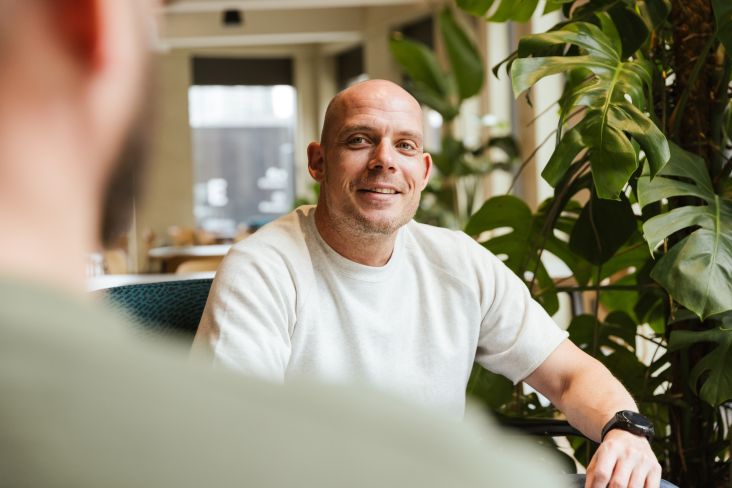Ian Morris on what it takes to be a successful children's book illustrator
Award-winning children's book illustrator Ian Morris reveals how he broke into the industry, why he prefers older artists, and what he keeps in mind when drawing for young audiences.

Ian Morris's career as an illustrator has got off to an explosive start. Having graduated from the University of Salford, he's gone on to work with the likes of Thames & Hudson, Bloomsbury, and The National Literacy Trust, as well as scooping up prestigious awards and nominations for his picture book work.
And it's no surprise to see why he's so in demand. His style, which is at once unique while echoing the greats like Quentin Blake, is so beautiful and packed with personality that viewers of all ages can't help but get drawn in. Little wonder then that his work is the culmination of a lifelong love of drawing.
"My love for illustration was there from a young age," he tells Creative Boom. "The ability – and love for — drawing runs through the Morris family. My Grandad 'Naughty' Morris was encouraged to attend art school by his teacher. However, he was from a poor working-class area of Manchester. His dad thought it was nonsense, making him get a proper job."
Thankfully, a similar fate did not befall Ian. He can juggle his illustration work with lecturing at the Manchester School of Art, although at the spritely age of 28, he's sometimes mistaken for a student himself. "I revel in seeing the students blossom, and they help keep me grounded with remembering where I was once," he explains.
Origin story
Like many artists, Ian can remember the work that initially grabbed his attention. In his case, it was the Beano and Dandy comics that his grandad would show him on his weekly visits. "I used to redraw the characters and develop my own comic narratives for them. They are happy, cherished memories."


In terms of picture books, though, it was a copy of The Last of the Sky Pirates illustrated by Chris Riddell, which caught his eye at first. "If anyone knows of Chris's work, I think the instant attraction is the quality of draughtsmanship and elegant detail in his work," he reveals.
"I was in awe of his drawings, and I still am, which is why it is still surreal that he endorsed my first picture book, The Library Book, created with writer Gabby Dawnay. When I revisited my primary school to open the newly refurbished library for World Book Day, his book was still on the shelf almost 20 years later, enjoyed by another generation of readers."
Curiously, though, reading was a bit of a difficulty for Ian early on. His education at a Montessori nursery in Prestwich encouraged him to explore his natural interests rather than a formal curriculum, resulting in much more drawing than reading.
"However, when I did catch up with my reading in primary school, my fondest books were The Edge Chronicles, Captain Underpants and The War Diaries of Alistair Fury series," he adds.
"Two of those books were very influential. The first, illustrated by Chris Riddell, was Captain Underpants because I could relate so much to the characters George and Harold creating their own comics and bringing their creations to life. Despite my early struggles, I'm a very avid reader, even promoting reading as a Literacy Champion for Manchester Central Library."
Ian didn't specialise in children's book illustration right away, though. To begin with, he pursued a graphic design course that offered three potential pathways upon completion. Fortunately, one of these routes was illustration, and Ian felt increasingly drawn towards it as time passed.


"After my BA, I studied for a Masters in Illustration at Manchester School of Art," he says. "Reflecting now, it may have been wise to study the MA Children's Book Illustration course at Cambridge School of Art. They have a heavy output of students entering the publishing world; however, moving down south was never feasible. Manchester has always been my home, and I probably would've hated the southern water as I love a good brew."
Getting to work
When making his illustrations, Ian uses anything that can make marks. "I predominantly use dip and reed pens for linework, pencil crayon and pastels for texture, and brushes for more painterly marks with watercolour and gouache," he says. "However, I am also interested in printmaking methods, screenprinting, mono printing, etching, and true grain. This is usually used for personal work away from the children's books.
"I'm always looking to improve, whether with guidance from a fantastic art director (Susi Martin!) or reading many books on the greats to understand their technique. I think it's important to be humble and not view yourself as a finished article. We should all be continually learning and developing."
This commendable work ethic reflects his outlook on other illustrators. Ian admires Raymond Briggs, Quentin Blake, Andre Francois, Gerald Rose, Ronald Searle, John Burningham, and Emmanuel Luzzati; however, he thinks contemporary artists leave something to be desired.
"Personally, I believe a lot of children's book illustration has become too homogenised and less focused on the idiosyncrasies of the visual language, which is still prevalent in older illustration work," he says. "It's actually quite rare that I get hooked by modern illustration, though I do like the work of Beatrice Alemagna."


Ian's discerning eye quickly stood out to commissioning editors. His first paid illustration job was with BBC History Magazine, where he worked with art director Suzanne Frank on an article about cross-dressers from the English Civil War.
"I'd finished my Masters in September 2018 and had posted her a newspaper of my work," he says. "It wasn't until nine months later that I received an email offering an editorial commission.
"As a weird coincidence, she sent me an example of a previous commission by Ben Jones, now one of my colleagues at Manchester School of Art. This first commission was a catalyst in growing my confidence, teaching me that there is value to my work and I can pursue this as a career."
Gaining recognition
This proved to be the first in a long line of commissions. Since then, Ian has gone on to work for various clients and publications. But the world of editorial illustration attracted him the most for a while.
"It was a great pleasure to be the monthly illustrator for Prospect Magazine's Upfront article section," he says. "Mike Turner, the art director, was brilliant to work with. I always enjoyed the adrenaline of producing a series of spot illustrations with short deadlines, some with as little as 24 hours to complete before heading to print."
The value of Ian's work was further recognised in 2023 when he won the Children's Literature Book Festival Awards in the Illustrated Young Reader category. This award was handed to Ian for his work on Alfie's First Fight by Oliver Sykes and was very special to him as children voted for it.
"That's our audience, and if it's resonating with them, more publishers need to make note," Ian says. "Oliver's writing offers a diversity lacking in children's literature. That's become even clearer in his new poetry collection, We Are Family: Six Kids and a Super-Dad, published in May 2024."


Having met Oliver in 2021 at Manchester Central Library, the pair quickly realised they had much in common and couldn't wait to collaborate. "Oliver's altruistic nature is why I enjoy working with him," Ian adds. "He truly cares about others, building people up and giving them opportunities to flourish.
"I enjoy how he envisages a story or poem while still allowing my own interpretation to give another perspective to the writing. It's a symbiotic relationship between his words and my pictures. I believe Oliver has a great future ahead of him."
Looking ahead
Speaking of the future, Ian's work on Oliver's next book, We Are Family: Six Kids and a Super-Dad, has recently hit the shelves. And just like any other project, Ian's illustrations started as drawings in a sketchbook. "For We Are Family, it was filled with indistinct scribbles, doodles and drawings that only I could decipher," he reveals.
"In this phase of the work, I'm trying to place myself within the protagonist's shoes and understand the situation, atmosphere and tone of the writing. This allows me to simply make ideas without prejudice of how they appear. This allows me to develop them further when I begin reflecting upon the outcomes."


The hardest parts to illustrate were poems with a strong emotional tone, as Ian did not want his illustrations to overpower them and steal their focus. " I do enjoy the challenge of effectively communicating an illustration without overshadowing the words and allowing the writing to be engaging and thought-provoking," he says.
"My favourite illustration from the book is for the poem Space and Time. I enjoy my solitude, so I related a lot to this work. The image I created was actually based on a memory from my childhood.
"I had a friend in primary school called William, who lived in a lovely area called Birtle. A huge contrast to Middleton, where I lived. Anyway, I remember we went to a nearby patch of land by a stream. This illustration evokes many memories of that area.
"I think when illustrating or writing for children, you should never lose that essence of what it meant to be a child and how we all saw the world. I don't think I've ever lost that."
As for what's in store for Ian further down the line, poetry collections and more books appear to be in the works. "I'm currently developing my own picture book stories with the guidance of my agent, Neil of Spring Literary," Ian concludes.
"We came quite close last year with a story about a dragon called Bernard, but unfortunately,' there are too many dragons in the book world' was the response. I still think Bernard will shine in the future."




 by Tüpokompanii](https://www.creativeboom.com/upload/articles/58/58684538770fb5b428dc1882f7a732f153500153_732.jpg)


 using <a href="https://www.ohnotype.co/fonts/obviously" target="_blank">Obviously</a> by Oh No Type Co., Art Director, Brand & Creative—Spotify](https://www.creativeboom.com/upload/articles/6e/6ed31eddc26fa563f213fc76d6993dab9231ffe4_732.jpg)
















